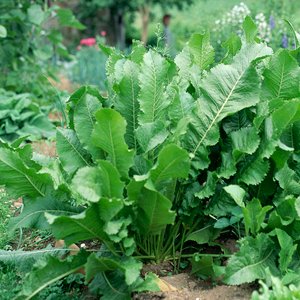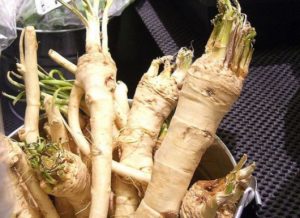
Horseradish thrives in full sun but tolerates light shade. Horseradish can take almost anything but consistently waterlogged conditions. Site your horseradish in an out-of-the way spot, because you won’t want to move this perennial once it is planted.
Grow horseradish from plants or root cuttings set out in spring or fall. You won’t be able to find seeds, but roots are often available at farmers’ markets, grocers, and retail and mail order nurseries. Cut off the top third to half of the root to use in the kitchen, saving the bottom part to plant. Loosen the soil to 12 inches deep and add a shovelful of compost. Plant the root cutting at a 45-degree angle, with the top of the cutting 2 inches below the soil line. Root cuttings from nurseries generally come precut and just need to be planted. One plant is usually plenty for a family. If you love horseradish so much that you need more than one plant, space them 30 inches apart. Water it once a week during dry spells and use a couple of inches of mulch around the plant to help conserve moisture.
You can enjoy your first horseradish harvest one year after planting. Carefully dig away the soil from around the main root, taking care to free up the side roots and remove them at the same time. For the best yields, Oregon State University recommends harvesting after frost kills the foliage. Scrub the main root under running water and dry well. If enclosed in a perforated plastic bag, horseradish root will keep in the vegetable bin of your refrigerator for three months or longer.
The most common issue gardeners face with horseradish is how to keep it from growing where they don’t want it. To control its spread, remove the entire root, including its branches, when harvesting; then replant only the number of roots you desire as plants for the following season. Whatever you do, don’t till up ground containing horseradish root or place roots in your compost pile, because you risk spreading the plant all over the garden.
Freshly grated horseradish emits fumes that can make your nose run and irritate your eyes, so prepare it in a well-ventilated area, or even outside if your eyes are extremely sensitive. First, peel a 3- to 4-inch section of root as you would a carrot. Cut it into half-inch chunks and drop them in a blender or food processor. Add ¼ cup cold water and a bit of crushed ice and grind to a fine texture. Have some white-wine or rice-wine vinegar handy.

